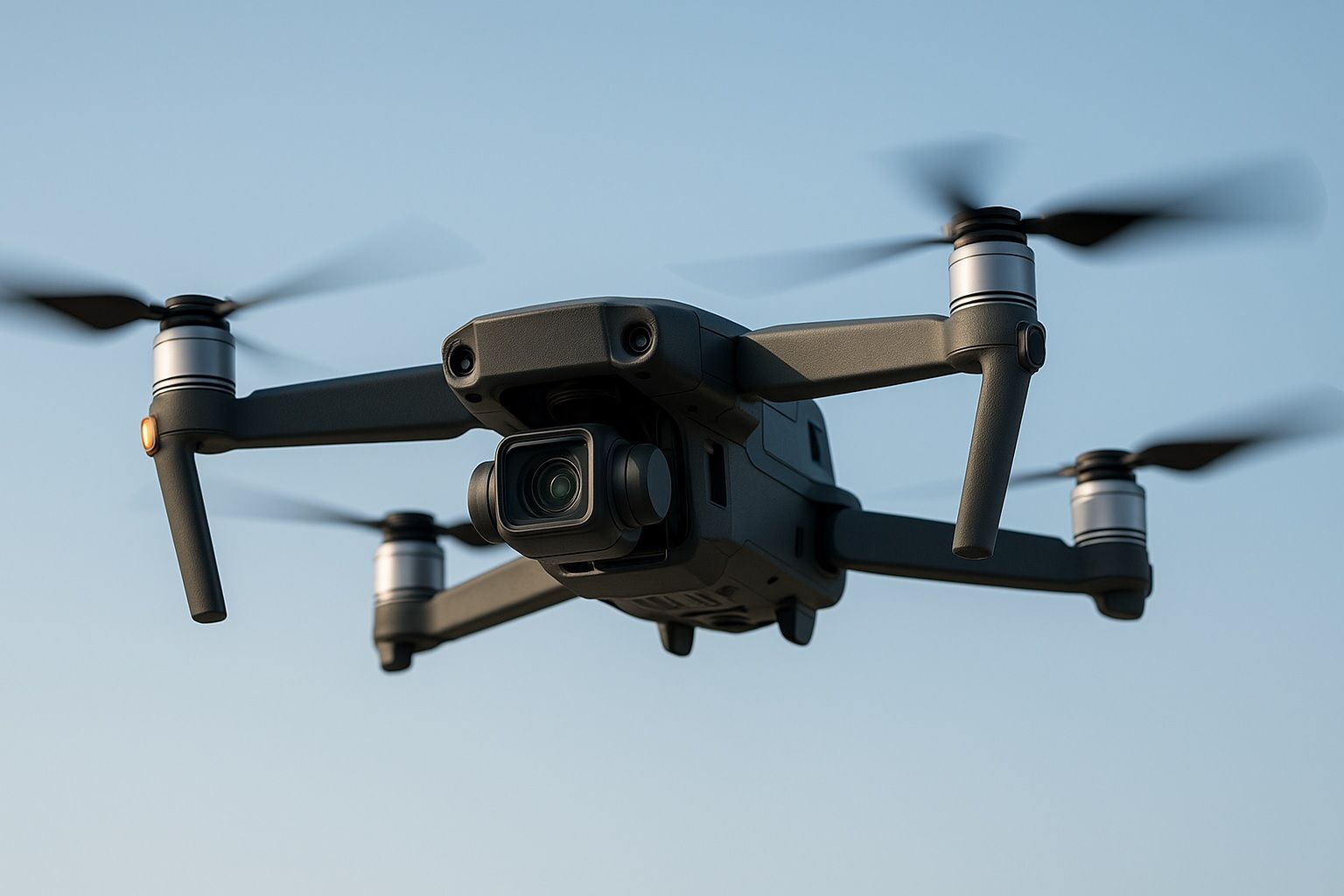- On July 3, 2025, Ukraine signed a co-production deal with U.S. firm Swift Beat to manufacture hundreds of thousands of drones in 2025, including interceptor, reconnaissance, and attack UAVs.
- DroneShield secured a $61.6 million contract to supply handheld drone detectors and jammers to a European military, with deliveries in Q3 2025 and plans for a European assembly facility.
- General Dynamics won a $580 million Army contract to sustain base protection systems, including radars and sensors to detect and stop unauthorized drones.
- Airbus Defence unveiled the SIRTAP prototype, a 20-hour ITAR-free reconnaissance UAV capable of 20,000+ ft, with first flight targeted for late 2025 and 27 units to the Spanish Army by 2027.
- Delair unveiled the DT61 long-range fixed-wing VTOL drone with increased payload for civil and military inspection and surveillance, launched at the Paris Air Show.
- France’s Parrot introduced the Anafi USA UKR micro-drone with enhanced encryption and anti-jamming for frontline defense and emergency responders.
- Israel’s Aeronautics Ltd. reported over $50 million in new Orbiter 4 orders from multiple international customers.
- John Deere completed the acquisition of Sentera in June 2025 to bolster its precision farming platform with drone analytics.
- India’s Raphe MPhibr raised $100 million in a Series B led by General Catalyst, valuing the startup at around $400 million post-money.
- On June 6, 2025, the White House issued two executive orders to accelerate BVLOS and domestic drone production and to expand counter-UAS and airspace security.
The early summer of 2025 saw rapid developments in the drone and unmanned aerial systems (UAS) sector. Global military demand for drones surged with record contracts and new production partnerships, while commercial drone services expanded into food delivery, agriculture, and logistics. Regulatory and policy actions – led by major U.S. executive orders – aimed to accelerate drone integration and strengthen airspace security. Technological breakthroughs included new long-range drones, micro-UAV prototypes, and advances in autonomous flight. Below, we detail the key news and trends from June and July 2025, organized by sector and theme, with sources for each item.
Military and Defense UAS Developments
- Ukraine Boosts Drone Arsenal: Ukraine signed a major co-production deal with U.S. firm Swift Beat to manufacture “hundreds of thousands” of drones in 2025 [1] [2]. The partnership (announced by President Zelensky on July 3) will produce various UAV types – especially interceptor drones to shoot down enemy drones and missiles – alongside reconnaissance and attack models. Zelensky emphasized that “the key priority is interceptor drones that have already proven effective in Ukraine” [3]. Swift Beat will scale up production into 2026, supplying modern drones to Ukraine “on special terms and at cost” amid increasing demand [4].
- Record Defense Contracts in Counter-Drone Tech: The rise of drone threats is driving huge counter-UAS investments. Australia-based DroneShield secured its largest order ever – a $61.6 million contract to supply a European military with handheld drone detectors and jammers [5] [6]. Deliveries are set for Q3 2025, and DroneShield is establishing a European assembly facility as defense customers move from testing to “broader rollouts” of counter-drone systems [7]. In the US, General Dynamics won a $580 million Army contract to sustain base protection systems, including radars and sensors to detect and stop unauthorized drones [8] [9]. These investments underscore a global priority to harden military sites and critical infrastructure against hostile UAS incursions.
- New Military Drone Systems Unveiled: Several advanced military drones debuted in June 2025. Airbus Defence rolled out the first prototype of SIRTAP, a tactical UAV co-developed with Spain. SIRTAP is an ITAR-free reconnaissance drone that can fly 20 hours at 20,000+ ft and operate in extreme temperatures [10] [11]. Ground tests begin in Spain, with a first flight targeted by late 2025 and deliveries of 27 units to the Spanish Army by 2027 [12] [13]. Airbus’s head of air power lauded the rapid timeline (“we will fly the prototype by the end of this year… deliver in the first half of 2027”) as evidence that even big manufacturers can move fast [14]. In France, drone-maker Delair unveiled the new DT61 long-range UAV at the Paris Air Show. The DT61 is a fixed-wing VTOL drone with greatly increased payload capacity, designed for “inspection and surveillance of large land and sea areas” in both civil and military contexts [15]. It expands Delair’s portfolio with a heavy-lift, multi-mission aircraft for extended-range operations [16]. And in a move toward smaller battlefield UAS, France’s Parrot introduced the Anafi USA “UKR” micro-drone, tailored for defense and emergency responders in conflict zones (with enhanced encryption and anti-jamming for frontline use [17]).
- Defense Drone Orders and Investments: Israel’s Aeronautics Ltd. reported over $50 million in new contracts from multiple international customers for its Orbiter 4 tactical UAS [18]. The Orbiter 4 is a Group 3 ISR drone (land or maritime) known for extended endurance and multi-payload flexibility, which Aeronautics says “sets a new benchmark for mission flexibility and survivability” on the modern battlefield [19] [20]. In Turkey, drone-maker Baykar continued to see strong interest in its Bayraktar TB2 and Akinci drones (following their high-profile use in recent conflicts), though no new deals were publicly announced in June–July. Meanwhile, defense-tech startups attracted funding: India’s Raphe MPhibr raised $100 million to expand indigenous military drone production [21] [22]. The Series B round (led by General Catalyst) comes as India triples its drone budget to $470 million after witnessing large-scale drone use in recent conflicts [23]. Raphe produces a range of UAVs – from lightweight quadcopters to 200kg VTOL platforms – and supplies India’s Army, Navy, Air Force and border forces [24], bolstering India’s domestic drone capabilities in a field still dominated by foreign OEMs [25].
- China’s Next-Gen “Mosquito” Drone: Chinese researchers revealed a prototype micro-drone resembling a mosquito, underscoring interest in biomimetic spy devices. In a June CCTV-7 broadcast, China’s National University of Defense Technology demonstrated a tiny robot with two flapping wings and three leg-like supports [26] [27]. Controlled via smartphone, the insect-sized drone is intended for covert reconnaissance in the field. An NUDT student presenter noted such “miniature bionic robots” are well-suited to gather intelligence on the battlefield [28]. While the prototype’s payload and endurance are very limited (a perennial challenge for micro-UAS), advances in AI and micro-electronics may eventually make swarms of these “mosquito drones” viable for surveillance [29]. China’s investment in novel drone tech – from large UAVs to tiny spy drones – highlights the escalating global race for drone supremacy at all scales.
- Wartime Innovations and Tactics: The high-intensity conflict in Ukraine continues to spur drone innovation and tactics. Ukrainian forces report success using small FPV kamikaze drones and improvised drone-dropped munitions against armored targets, prompting allied countries to accelerate donations of similar loitering munitions. Russia, for its part, has ramped up mass drone and missile strikes, though Ukraine’s new intercept drones aim to blunt those barrages [30] [31]. On the defensive side, frontline units in Ukraine have even developed “drone-proof” field fortifications and concealing techniques; one Ukrainian commander gained attention for designing “drone-proof” camouflage uniforms to evade thermal sensors (reportedly cutting detection by enemy drones) [32]. These grassroots adaptations underscore how drone warfare has become a defining element of modern combat – driving both procurement of high-end systems and DIY battlefield solutions.
Commercial and Civil Drone Industry Updates
- Drone Delivery Milestones: Commercial drone delivery saw notable expansions. Food-delivery giant DoorDash, in partnership with drone startup Flytrex, launched an on-demand drone delivery service in the Dallas–Fort Worth area of Texas [33]. As of late June, customers in parts of Frisco and Little Elm can order meals from dozens of restaurants via the DoorDash app and opt for drone delivery, with Flytrex’s autonomous drones lowering orders into backyards [34]. This is Flytrex’s first integration into a third-party consumer app, reaching over 30,000 households with operating hours from 8:00am to 9:30pm [35]. DoorDash touts that the program offers the region’s widest drone delivery window and largest payload capacity (Flytrex drones carry up to 6.6 lbs, soon 8.8 lbs) – enabling more order volume and “expanded capabilities that unlock a broader range of use cases” in suburban logistics [36]. Meanwhile, Amazon’s Prime Air drone delivery program made regulatory headway: on June 9, the San Antonio City Council approved zoning variances to let Amazon build a drone delivery center at an existing warehouse [37]. The facility will have launch/landing pads and charging stations to support Prime Air drones delivering packages under 5 pounds within a 7.5-mile radius [38] [39]. Despite some local skepticism (concerns about job impact and safety), the 8–2 council vote clears the way for San Antonio to join Amazon’s drone delivery network (alongside College Station, TX and Lockeford/Tolleson, AZ) [40] [41]. Amazon aims to deliver orders in under 60 minutes via its FAA-approved MK30 drones, and this new site will help scale operations in Texas [42].
- Agriculture and Industrial Drones: Drones are transforming agriculture with greater efficiency. In early July, Hungary-based ABZ Innovation launched the L30 V2 agricultural drone, a heavy-duty crop-sprayer with a 30-liter tank [43]. The L30 V2 can spray up to 21 hectares per hour thanks to a high flow rate (16 L/min) and minimal downtime – each battery+tank covers ~2.4 ha before swap [44]. It features advanced autonomy: LiDAR-based obstacle avoidance (to detect trees, power lines, terrain) and automated terrain following to keep a consistent spray height [45]. In field trials on citrus farms, this drone achieved 90% water savings (cutting usage from 2000 L/ha to 200 L/ha by precision targeting) [46]. With such efficiency and an operating cost of only ~€1.2 per hectare, ABZ claims the L30 V2 is among the most cost-effective large spraying drones [47]. The system is modular (it can be outfitted with a granular spreader for seeding/fertilizing) and designed to reduce labor and chemical exposure on farms [48]. Major agriculture players are taking notice: U.S. equipment giant John Deere acquired drone analytics startup Sentera in June to bolster Deere’s precision farming platform [49] [50]. Sentera (Minneapolis-based, ~50 employees) provides high-resolution aerial crop scouting via drone-mounted sensors; its tools can map weeds, assess crop health, and integrate with Deere’s Operations Center software [51] [52]. Deere had partnered with Sentera for years, but now fully bringing it in-house will allow farmers to seamlessly gather drone data and get real-time agronomic insights through Deere’s system [53]. The acquisition (announced May 23) reflects how traditional ag machinery firms are investing in drone and data tech to enhance yields and reduce input costs.
- Enterprise and Delivery Drone Expansions: European drone makers secured funding to scale their operations. Germany’s Wingcopter, known for its long-range delivery drones (e.g. Wingcopter 198), received fresh investment from the Nordic Secondary Fund and the European Investment Bank in June [54]. This funding (undisclosed amount) comes as Wingcopter nears type certification for its eVTOL delivery drones in the US, Brazil, and Japan [55]. Wingcopter is also branching into infrastructure inspection services using LiDAR-equipped drones [56]. The new capital and a strengthened leadership team are meant to help Wingcopter become a “European tech champion” in unmanned aviation – delivering sustainable instant delivery of medical supplies and efficient aerial inspection of critical infrastructure with one multi-purpose platform [57] [58]. Elsewhere, Zipline (USA) and Matternet continued expanding medical drone deliveries in new cities, and UK-based Windracers announced a humanitarian drone initiative with NGO Aviation Sans Frontières to transport medical cargo to remote African communities [59] [60]. On the retail front, U.S. big-box retailers are exploring drones: Walmart-backed DroneUp and others are steadily increasing their service areas (though no singular breakthrough was reported in June–July). Not all news was positive: retail availability of DJI drones in the U.S. saw disruptions – by late June many DJI models were out of stock or backordered at major retailers, apparently due to a Customs-related import holdup. DJI’s U.S. webstore showed no drones available [61], and retailers like Best Buy cited the “volatile U.S.-China tariff situation” as a reason they’re not stocking DJI drones [62] [63]. DJI stated it was working with U.S. Customs to resolve a “misunderstanding” that has temporarily limited its ability to import product, expressing hope for a quick resolution [64]. This situation, along with ongoing U.S. government procurement bans on Chinese drones, is prompting enterprise users to consider alternative suppliers, even as DJI remains the global market leader in the consumer/prosumer segment.
Regulatory and Policy Updates
- U.S. Executive Orders Transforming Drone Policy: In a landmark move, on June 6 the White House issued two major executive orders aimed at boosting the U.S. drone industry and securing American airspace. The first order, “Unleashing American Drone Dominance,” directs the FAA and other agencies to aggressively accelerate drone integration and domestic production [65] [66]. It calls for a proposed rule to allow routine beyond visual line-of-sight (BVLOS) flights within 30 days and a final BVLOS rule by early 2026 [67]. Industry leaders hailed this step – the lack of a unified BVLOS regulation has long forced drone operators to seek cumbersome waivers, limiting scalable operations. “What makes us most excited is that it pushes on initiating more streamlined BVLOS flights,” said David Benowitz of drone maker BRINC, praising the order’s focus on the long-awaited Part 108 rule [68]. The order also mandates that the FAA deploy AI tools to expedite drone waiver approvals by October 2025 and identify categories of low-risk operations that could be allowed without waivers [69] [70]. Additionally, it prioritizes U.S.-made drones in federal procurement and seeks to establish a “covered list” of foreign drone entities that pose supply chain risks (targeting Chinese manufacturers) [71] [72]. The second order, “Restoring American Airspace Sovereignty,” tackles security threats from nefarious drone use [73] [74]. It sets up a federal task force on counter-UAS, urges faster FAA rulemaking to restrict drones over critical infrastructure, and expands grants for state/local authorities to buy drone detection and mitigation systems [75] [76]. It also pushes the Justice Department to enforce laws against dangerous drone operations and consider stiffer criminal penalties [77]. Together, these EOs mark a pivotal U.S. policy shift: aggressively enabling beneficial drone operations (like delivery, infrastructure inspection, and advanced air mobility) while cracking down on illicit or hostile UAS use. Industry groups like AUVSI and the Commercial Drone Alliance applauded the moves, noting they provide much-needed timelines and “stepping stones” toward full UAS integration [78] [79] – though successful implementation will depend on swift follow-up by the FAA, FCC, and other agencies.
- Global Regulatory Moves: Authorities worldwide also updated drone policies. In Europe, regulators are focusing on harmonizing standards and enabling advanced operations. The European Union Aviation Safety Agency (EASA) published new guidelines and a Safety Information Bulletin highlighting risks from drones near conflict zones (after incidents of spillover from the Ukraine war). The EU is also rolling out its U-space framework for drone traffic management across member states, and EASA’s Drone Economy Dashboard (May 2025 edition) showed continued growth in EU drone startups and investments [80]. At the Paris Air Show, European industry leaders urged streamlined certification for new UAVs – many companies showcased “ITAR-free” drones (free of U.S. export controls) to ease international sales [81]. Hong Kong announced plans in June to relax strict drone flight rules that had constrained commercial use [82]. The Hong Kong government’s proposal would open more airspace to drones and simplify permits, aiming to spur innovation (e.g. in aerial filming, logistics and surveying) while balancing public safety. In Africa, Nigeria and South Africa held stakeholder forums in July on updating their drone regulations to accommodate drone deliveries and surveillance uses in agriculture. And in Latin America, Brazil’s ANAC reported a sharp increase in registered drone operators after implementing its online licensing system, prompting plans to introduce BVLOS operation waivers similar to the FAA’s system. Across the globe, regulators are grappling with the same challenge: integrating drones into airspace safely without stifling growth. The consensus emerging in mid-2025 is for risk-based rules that allow expanded operations (like BVLOS and flights over people) in low-risk scenarios, coupled with remote ID requirements and geofencing to manage security.
- Expert Forecasts and Industry Outlook: Industry analysts remain bullish on the drone sector’s trajectory. Drone Industry Insights (DRONEII) updated their market forecast, projecting the global drone market to grow to $95 billion by 2030, driven by steep adoption in cargo delivery, agriculture, and public safety. Investment bank briefings in July noted an uptick in M&A and funding in drone tech, calling 2025 a “consolidation point” as larger firms snap up niche drone startups (e.g. Deere–Sentera, and the canceled plan of Unusual Machines to acquire software maker Aloft) [83]. Defense contractors at the Paris Air Show predicted that “every future conflict will involve ubiquitous drones,” fueling steady demand for both combat UAVs and anti-drone systems. Reflecting on the U.S. executive actions, Oklahoma State’s Dr. Jamey Jacob said the new BVLOS mandate would “spur renewed investment in the commercial drone industry”, by signaling that routine long-range operations will soon be viable [84] [85]. However, experts also caution about regulatory delays: even with political support, drafting and implementing complex drone rules (such as autonomous air taxi certification) may take longer than hoped. Overall, the sentiment in mid-2025 is optimistic – drones are increasingly mainstream tools in industries from e-commerce to engineering – but stakeholders urge continued focus on safety, public acceptance, and airspace integration to unlock the technology’s full economic potential.
Technological Breakthroughs and New UAS Products
- Autonomous Cargo and eVTOL Advances: Several breakthrough demonstrations proved the maturity of autonomous flight. California-based startup MightyFly completed a successful test of its Cento autonomous cargo eVTOL for the U.S. Air Force in May (revealed in June) [86] [87]. In a live demo under an Air Force SBIR contract, the Cento aircraft autonomously flew a multi-leg mission: it self-loaded two large cargo boxes using its patented robotic cargo bay (Autonomous Load Mastering System), took off vertically, transitioned to winged cruise flight, then landed and automatically unloaded the packages at the destination – all without human intervention [88] [89]. The Cento (a hybrid-electric VTOL) can carry up to 100 lbs over 600+ miles, and performed mixed civilian/military payload demos (medical supplies, manufacturing parts, etc.) to showcase versatility [90]. This kind of end-to-end autonomous logistics is a key step toward routine cargo drone services for both defense and commercial supply chains. The White House’s June drone initiative even cited eVTOL cargo craft for “modernizing cargo transport and rural access” in its vision for advanced air mobility [91], aligning with companies like MightyFly. On the passenger eVTOL front, several air taxi prototypes (Joby, Volocopter, Lilium) were exhibited at Paris, but the focus at the show tilted toward unmanned systems and dual-use drones this year [92] [93].
- Surveillance and Reconnaissance Upgrades: Long-range surveillance drones are getting more capable. Delair’s DT61 (launched at Paris) is a fixed-wing VTOL with extended endurance and payload for border patrol, maritime surveillance, and mapping – filling a gap between small quadcopters and large military UAVs [94] [95]. In the U.S., startup Quantum-Systems (maker of the Vector/Phoenix series) entered a strategic partnership with Airbus to build an “open reconnaissance ecosystem” for European defense [96] [97]. Announced June 17, the collaboration will integrate Quantum’s small tactical drones with Airbus’ intelligence systems, using AI to fuse data – a move aimed at Europe’s push for sovereign ISR capabilities. Smaller innovators are also enhancing ISR: France’s Parrot Anafi UKR, as mentioned, is a micro-drone built for frontline scouting with secure communications [98]. And U.S.-based Skydio released a software update in July enabling its drones to autonomously create 3D digital twins of infrastructure, catering to inspection needs in telecom and utilities.
- Counter-Drone Tech and AI: As drones proliferate, so do counter-drone innovations. Apart from big contracts for systems (like DroneShield’s, noted above), companies are refining their technology. Dedrone and D-Fend both announced updates to their drone detection and mitigation platforms in June: Dedrone unveiled an AI-powered pattern recognition that improves detection of swarms and DIY drones by 30%, and D-Fend launched a new handheld RF jammer that can safely takeover rogue drones without GPS disruption. The Pentagon’s Joint C-sUAS office, in a report to Congress, highlighted promising directed-energy systems (lasers and microwaves) that were tested successfully against drones this summer – one kw-class laser downed targets at >1 km range in trials. While these aren’t products yet, it signals that high-tech anti-drone weapons are nearing operational readiness for base defense and mobile protection of troops.
- Miscellaneous Innovations: Startups worldwide are finding novel drone applications. In June, Kaman Air Vehicles demonstrated autonomous water sampling by drone for environmental monitoring – a multi-rotor UAS collected water from different depths in a lake and returned samples to a lab autonomously. In Japan, NTT DoCoMo began testing 5G-connected drones to provide emergency cellular coverage during disasters, launching balloon-loitering drones as flying cell towers. Additionally, the entertainment industry hit a milestone: on July 2, rock band Oasis (in a highly anticipated reunion) opened their concert with a 1,000-drone aerial light show over London, one of the largest drone swarms ever used in a live event. The spectacle, which formed dynamic images above Wembley Stadium, exemplified how choreographed UAV swarms are becoming mainstream in events – though safety regulators note that proper geo-fencing and “drone show standards” (an ASTM task force for which was formed June 17 [99]) are crucial to prevent mishaps. Finally, power technology crossed into the drone world: DJI (better known for drones) surprised by launching a portable battery station (“Power 2000”) in late June, potentially to support remote drone operations and charging. This diversification hints that drone firms see opportunities in the broader ecosystem supporting unmanned systems.
Major Contracts, Investments, and Mergers in the UAS Sector
- Defense and Government Contracts: As detailed earlier, June brought an avalanche of defense-focused awards. Highlights include the $40 million (AUD 61.6M) contract won by DroneShield to supply a European military with counter-drone gear – the largest deal in the company’s history [100] [101]. The U.S. Army’s $580 million award to GDIT for base security systems (with anti-drone components) was another blockbuster [102]. The U.S. Air Force, through its AFWERX program, granted Skyways $37 million to scale up production of its V3 autonomous cargo drones [103]. This funding will help Skyways transition its long-range heavy-lift drone from prototype to mass production, aiming to deploy “thousands of V3 aircraft for both military and commercial missions” over the next five years [104] [105]. Notably, the Skyways V3 can carry 100 lbs over 1,000+ miles (20+ hours endurance) using a hybrid VTOL design [106], a capability that attracted the Air Force’s interest in unmanned logistics. In Israel, Aeronautics Ltd. secured ~$50 million in orders for its Orbiter 4 drones [107], and Turkey’s Baykar reportedly inked a follow-on export contract for TB2 drones with an undisclosed European country (though financial details were not public by July). These contracts reflect robust defense spending on drones and counter-drones, driven by both geopolitical conflicts and the need to modernize forces.
- Investments and Funding Rounds: Venture investment in drone companies remained strong. The largest disclosed round was the $100 million Series B raised by India’s Raphe MPhibr for military UAS manufacturing [108]. In Europe, Dronamics (Bulgaria) won a €30 million equity investment from the EU’s EIC fund to scale its Black Swan cargo drones [109] [110] – the EU is doubling down on Dronamics as a strategic asset for autonomous cargo (the Black Swan can carry 350 kg over 2,500 km) [111] [112], aligning with Europe’s goal of tech sovereignty in drones. German delivery-drone maker Wingcopter received new funding (amount undisclosed) from the Nordic Secondary Fund and others, as noted, to fuel its growth and certification efforts [113]. In the U.S., Seattle-based Echodyne, which builds radar for drone detect-and-avoid, closed a $20M round in June (investors see a big future for radar in enabling BVLOS flight). And late in July, Skyways (after the AFWERX award) also raised an additional $5M from private investors to accelerate its manufacturing, indicating confidence in its DoD contracts [114].
- Mergers & Acquisitions: The period saw strategic acquisitions as larger companies integrate drone tech. John Deere’s purchase of Sentera (detailed in the Commercial section) stands out – it brings advanced drone imaging capabilities under the umbrella of an agriculture giant, highlighting the value of aerial data in precision farming [115] [116]. In the drone tech supply chain, Unusual Machines Inc. – an Orlando-based drone components manufacturer – signed an agreement to acquire Rotor Lab of Australia, a maker of high-performance electric motors for UAVs [117]. The all-stock deal is valued at $7 million and will give Unusual Machines its own in-house motor designs, strengthening a resilient UAS supply chain (the company notes the drone parts market is projected to grow to $115B by 2032) [118] [119]. Rotor Lab’s Canberra facility will continue R&D and low-volume production, while Unusual Machines opens a new motor factory in Florida in late 2025 to mass-produce these motors for both small and large drones [120] [121]. Another notable tie-up: defense tech firm Anduril announced a partnership with Germany’s Rheinmetall during the Paris Air Show to co-develop drone and counter-drone systems for European militaries [122] – a prelude to possible JV or M&A activity as U.S. and European defense tech aligns. On the commercial side, there was a rare cross-border acquisition: Japanese drone services provider Terra Drone acquired a majority stake in Belgium’s Skeye BV in July, expanding its footprint in Europe’s inspection market. Overall, mergers in mid-2025 point to vertical integration (e.g., hardware makers absorbing suppliers) and market consolidation (bigger firms acquiring specialized startups) as the drone industry matures.
- Public Offerings and Valuations: No major drone company IPOs occurred in June–July 2025, but there were signs of capital market interest. Chinese drone giant DJI remained privately held (amid speculation of an eventual IPO once geopolitical tensions ease). However, in the US, several drone-adjacent companies (like Lidar makers and air taxi firms) saw their stock prices rise on news of government support for UAV integration. For example, upon President Trump’s drone executive orders, the stock of Red Cat Holdings (parent of dronemaker Teal) jumped 15% in a week [123], as investors bet domestic manufacturers could benefit from the “Buy American” push for drones [124]. And Kratos Defense, which produces tactical UAVs, reported increased inquiries from allies in Europe and Asia, potentially boosting its backlog. In India, the fresh funding of Raphe mPhibr valued the startup at around $400M (post-money), making it one of India’s most valuable drone firms and underlining how regional conflicts (like the South Asia tensions) are driving investor appetite in the sector [125] [126].
Sources: The information above is compiled from a range of industry news outlets, press releases, and official statements in June–July 2025. Key sources include company press releases [127] [128], defense and tech news sites (e.g. Kyiv Independent [129] [130], DroneLife [131] [132], Aerospace Testing Intl. [133] [134]), government releases (White House Executive Order fact sheets [135] [136]), and analysis by industry experts. Each news item and quote is linked to its original source for further reading. This period’s developments demonstrate the fast-paced evolution of the UAS landscape – with significant implications for investors, aerospace and defense companies, and policymakers alike as drones become ever more entrenched in both commerce and security.
References
1. kyivindependent.com, 2. kyivindependent.com, 3. kyivindependent.com, 4. kyivindependent.com, 5. www.droneshield.com, 6. www.droneshield.com, 7. www.droneshield.com, 8. www.unmannedairspace.info, 9. www.unmannedairspace.info, 10. www.aerospacetestinginternational.com, 11. www.aerospacetestinginternational.com, 12. www.aerospacetestinginternational.com, 13. www.aerospacetestinginternational.com, 14. www.aerospacetestinginternational.com, 15. delair.aero, 16. dronelife.com, 17. dronelife.com, 18. www.thedroningcompany.com, 19. www.thedroningcompany.com, 20. www.thedroningcompany.com, 21. techcrunch.com, 22. techcrunch.com, 23. techcrunch.com, 24. techcrunch.com, 25. techcrunch.com, 26. www.thedroningcompany.com, 27. www.thedroningcompany.com, 28. www.thedroningcompany.com, 29. www.thedroningcompany.com, 30. kyivindependent.com, 31. kyivindependent.com, 32. www.thedroningcompany.com, 33. www.thedroningcompany.com, 34. www.thedroningcompany.com, 35. www.thedroningcompany.com, 36. www.thedroningcompany.com, 37. spectrumlocalnews.com, 38. spectrumlocalnews.com, 39. spectrumlocalnews.com, 40. spectrumlocalnews.com, 41. spectrumlocalnews.com, 42. spectrumlocalnews.com, 43. www.thedroningcompany.com, 44. www.thedroningcompany.com, 45. www.thedroningcompany.com, 46. www.thedroningcompany.com, 47. www.thedroningcompany.com, 48. www.thedroningcompany.com, 49. www.manufacturingdive.com, 50. www.manufacturingdive.com, 51. www.manufacturingdive.com, 52. www.manufacturingdive.com, 53. www.manufacturingdive.com, 54. siliconcanals.com, 55. siliconcanals.com, 56. siliconcanals.com, 57. siliconcanals.com, 58. siliconcanals.com, 59. dronelife.com, 60. dronelife.com, 61. www.thedroningcompany.com, 62. www.thedroningcompany.com, 63. www.thedroningcompany.com, 64. www.thedroningcompany.com, 65. dronelife.com, 66. dronelife.com, 67. dronexl.co, 68. dronelife.com, 69. dronexl.co, 70. dronexl.co, 71. dronexl.co, 72. dronexl.co, 73. www.whitehouse.gov, 74. www.whitehouse.gov, 75. www.whitehouse.gov, 76. www.whitehouse.gov, 77. www.whitehouse.gov, 78. dronelife.com, 79. dronelife.com, 80. www.linkedin.com, 81. www.aerospacetestinginternational.com, 82. www.unmannedairspace.info, 83. www.stocktitan.net, 84. dronelife.com, 85. dronelife.com, 86. www.thedroningcompany.com, 87. www.thedroningcompany.com, 88. www.thedroningcompany.com, 89. www.thedroningcompany.com, 90. www.thedroningcompany.com, 91. www.thedroningcompany.com, 92. www.youtube.com, 93. www.uasvision.com, 94. delair.aero, 95. dronelife.com, 96. dronelife.com, 97. dronelife.com, 98. dronelife.com, 99. www.unmannedairspace.info, 100. www.droneshield.com, 101. www.droneshield.com, 102. www.unmannedairspace.info, 103. dronelife.com, 104. dronelife.com, 105. dronelife.com, 106. dronelife.com, 107. www.thedroningcompany.com, 108. techcrunch.com, 109. therecursive.com, 110. therecursive.com, 111. therecursive.com, 112. therecursive.com, 113. siliconcanals.com, 114. dronelife.com, 115. www.manufacturingdive.com, 116. www.manufacturingdive.com, 117. www.auvsi.org, 118. www.auvsi.org, 119. www.auvsi.org, 120. www.auvsi.org, 121. www.auvsi.org, 122. breakingdefense.com, 123. dronelife.com, 124. dronexl.co, 125. techcrunch.com, 126. techcrunch.com, 127. www.droneshield.com, 128. www.droneshield.com, 129. kyivindependent.com, 130. kyivindependent.com, 131. dronelife.com, 132. dronelife.com, 133. www.aerospacetestinginternational.com, 134. www.aerospacetestinginternational.com, 135. dronelife.com, 136. www.whitehouse.gov










